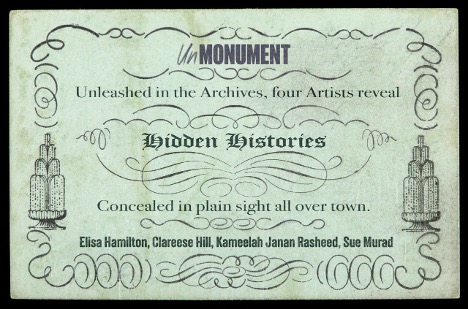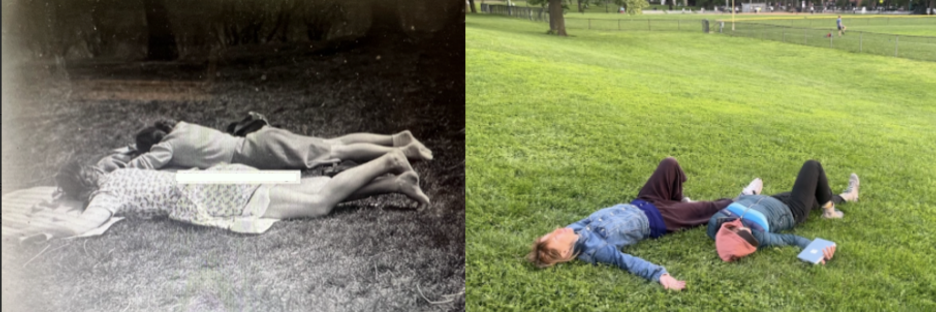Viewable through October 28, from Beacon Hill, Boston Common, and along MBTA Green and Orange Lines, and virtually via Hoverlay
Announcement
Boston, MA —
Emerson Contemporary, Emerson College’s platform for presenting contemporary visual art, enthusiastically announces Hidden Histories, a series of four public art activations produced as part of the Un-Monument initiative of the City of Boston, viewable September 1 through October 28. The exhibition can be viewed from Beacon Hill, Boston Common, and MBTA trains and stations along the Green and Orange Lines, and virtually via the Hoverlay augmented reality application. Un-Monument is a multi-year public art initiative to bring temporary monuments and free programming that expand the inclusive histories represented in public spaces across the City. Hidden Histories, curated and produced by Emerson Contemporary, highlights the processes of collaboration, artistic research, and speculation in contemporary art.

Combining the gallery’s mission to educate by doing, the inclusive experience of walking tours, and the idea that history is a living subject that constantly evolves, the artists received this prompt: find an aspect of the city’s past that is not currently well-known or understood and create art using new media technologies to amplify those stories. To create the series, Emerson Contemporary collaborated with Boston’s foremost historic archives: The Boston Athenaeum, Historic New England, and Massachusetts Historical Society, and the artists were subsequently invited as community research fellows. With the generous support and collaboration of archive staff, artists were provided access to their rich collections and many objects that served as inspiration for their thought-provoking projects.
The artists featured include Elisa Hamilton, Clareese Hill, Sue Murad, and Kameelah Janan Rasheed. Hamilton, an Emerson alumna, is a Boston-based socially engaged artist who creates community-centered projects that emphasize shared spaces. Clareese Hill is a practice-based researcher who explores “identity” through her perspective as an Afro-Caribbean American woman and Black feminist academic. Boston-based Murad responds to culture through an intuitive, sensory engagement with everyday objects, often in the public or private places. With an interest in the poetics and possibilities of loss, ruin, and failure in the reading and writing process, Los Angeles-based Rasheed explores writing practices across multiple media. Please see more artist information and images.
To support public access to Hidden Histories, Emerson Contemporary continues to build on its multi-year collaboration and partnership with Hoverlay, a Boston-based augmented reality platform where users can compose and publish immersive content. Hoverlay enables any storyteller to utilize AR to transform how they tell their stories by placing virtual story objects out in the world to be accessed by visitors’ smartphones. Public signage on Beacon Hill, the T and in the Common will provide a Qr code and instructions to download the app and access the exhibition.
This project is funded by the Mayor’s Office of Arts and Culture’s Un-monument initiative, supported by a grant from the Mellon Foundation.

About the Projects
Independent Ledger, March 3, 1783.
Elisa Hamilton’s project will present a series of digital vignettes honoring the life and legacy of Louis Glapion. Glapion was a French, biracial hairdresser and barber who, together with his friend George Middleton, built and owned what is now considered the oldest extant house in Beacon Hill, located at 5 Pinckney Street. While more is known about Middleton, the artist’s research has uncovered glimpses of Glapion that speak to an interesting and noteworthy life based in Beacon Hill. Hamilton seeks to honor Glapion and enliven curiosity about his lived experiences in our city. The AR experience will be available on Hoverlay and accompanied by a research document designed for educational purposes.

Sue Murad, ASSEMBLE, Performance Action, Boston Common, 2025.
Sue Murad’s ASSEMBLE: Performance Instructions For Public Arrangements is a participatory performance that reflects on the ways we gather in public space—particularly the historic Boston Common—through the objects we bring with us or discover there. It is a guided, interactive experience that unfolds across the landscape, inviting participants into temporary arrangements shaped by memory, proximity, and shared attention. The project bears witness to the many generations of people who have gathered together for rest and rallies, labor and loitering, play and protest. As such, Murad presents a contemplative investigation of the often overlooked First Amendment right to peacefully assemble.
Clareese Hill’s The Black Boston Dream Oracle is a speculative reimagining of The Complete Fortune Teller and Dream Book written by Chloe Russel, a 19th-century Black woman from Massachusetts. By blending historical wisdom with future-focused fabulations, the Black Boston Dream Oracle will provide a unique space for reflection, healing, and imagining new possibilities for liberation and collective well-being through early Black feminist thought. The Oracle will be presented as an Extended Reality (XR) experience available on the Hoverlay application, accompanied by a web-based research document designed for educational purposes.
Kameelah J. Rasheed responds to Boston's memorial landscape by exploring the layered histories of Boston as discovered in the archives of the Boston Athenaeum. Rasheed gathered marginalia and ornate typefaces from their collection of Boston’s oldest books. These fragments are interwoven or sampled into digital designs to form visual poems to be displayed on digital signage situated around the Boston Common. Additionally, the poems will be placed inside public transit cars on the Orange and Green lines. The poems are inspired by Toni Morrison and act as an interruption in the ad-based public view to consider the complexities of our current socio-political context.
About Emerson Contemporary
Emerson Contemporary is the College’s platform for showcasing contemporary visual art. It is focused on presenting living artists, their ideas, experiments and creative practices in the areas of media art, performance art and emergent technologies, while critically examining these works in their social context.
About the College
Based in Boston, Massachusetts, opposite the historic Boston Common and in the heart of the city’s Theatre District, Emerson College educates individuals who will solve problems and change the world through engaged leadership in communication and the arts, a mission informed by liberal learning. The College has approximately 4,161 undergraduates and 554 graduate students from across the United States and nearly 70 countries. Supported by state-of-the-art facilities and a renowned faculty, students participate in more than 90 student organizations and performance groups. Emerson is known for its experiential learning programs at Emerson Los Angeles, located in Hollywood, and at its 14th-century castle, in the Netherlands. Additionally, there are opportunities to study in Washington, DC, London, China, the Czech Republic, Spain, Austria, Greece, France, Ireland, Mexico, Cuba, England, and South Africa. The College has an active network of 51,000+ alumni who hold leadership positions in communication and the arts. For more information, visit emerson.edu.
For more information contact
Rosemary Lavery